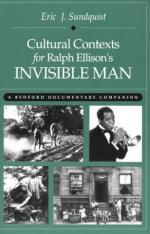|
This section contains 796 words (approx. 3 pages at 300 words per page) |

|
SOURCE: Blythe, Hal, and Charlie Sweet. “Ellison's ‘King of the Bingo Game.’” Explicator 58, no. 4 (summer 2000): 218-20.
In the following essay, Blythe and Sweet argue that Ellison's use of juxtaposition in “King of the Bingo Game” “makes more poignant the gap between white and black America in the 1930s.”
Critics have long recognized symbolism as one of Ralph Ellison's favorite devices. However, a lesser-known technique, juxtaposition, illuminates the racism theme so prominent in his classic short story “King of the Bingo Game.” By contrasting the main character's major fantasy with his real-life situation, Ellison makes more poignant the gap between white and black America in the 1930s.
Ellison opens the story by describing his black protagonist's recurring cinematic fantasy. For the fourth time his character is in a theater watching the same stereotypic action-adventure movie. In it the hero, enshrouded by darkness within a room, probes with “the beam...
|
This section contains 796 words (approx. 3 pages at 300 words per page) |

|


